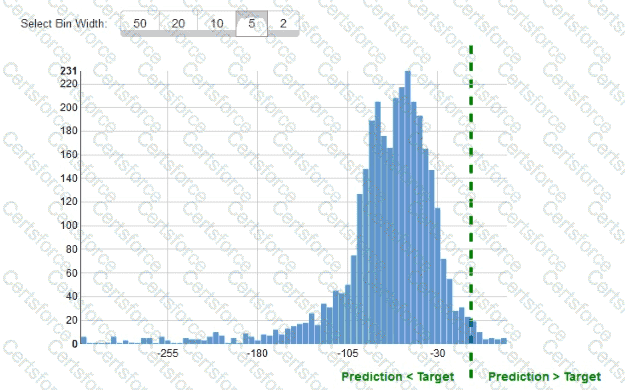A gaming company has launched an online game where people can start playing for free but they need to pay if they choose to use certain features The company needs to build an automated system to predict whether or not a new user will become a paid user within 1 year The company has gathered a labeled dataset from 1 million users
The training dataset consists of 1.000 positive samples (from users who ended up paying within 1 year) and 999.000 negative samples (from users who did not use any paid features) Each data sample consists of 200 features including user age, device, location, and play patterns
Using this dataset for training, the Data Science team trained a random forest model that converged with over 99% accuracy on the training set However, the prediction results on a test dataset were not satisfactory.
Which of the following approaches should the Data Science team take to mitigate this issue? (Select TWO.)
A company plans to build a custom natural language processing (NLP) model to classify and prioritize user feedback. The company hosts the data and all machine learning (ML) infrastructure in the AWS Cloud. The ML team works from the company's office, which has an IPsec VPN connection to one VPC in the AWS Cloud.
The company has set both the enableDnsHostnames attribute and the enableDnsSupport attribute of the VPC to true. The company's DNS resolvers point to the VPC DNS. The company does not allow the ML team to access Amazon SageMaker notebooks through connections that use the public internet. The connection must stay within a private network and within the AWS internal network.
Which solution will meet these requirements with the LEAST development effort?
Example Corp has an annual sale event from October to December. The company has sequential sales data from the past 15 years and wants to use Amazon ML to predict the sales for this year's upcoming event. Which method should Example Corp use to split the data into a training dataset and evaluation dataset?
A data scientist receives a new dataset in .csv format and stores the dataset in Amazon S3. The data scientist will use this dataset to train a machine learning (ML) model.
The data scientist first needs to identify any potential data quality issues in the dataset. The data scientist must identify values that are missing or values that are not valid. The data scientist must also identify the number of outliers in the dataset.
Which solution will meet these requirements with the LEAST operational effort?)
A company will use Amazon SageMaker to train and host a machine learning (ML) model for a marketing campaign. The majority of data is sensitive customer data. The data must be encrypted at rest. The company wants AWS to maintain the root of trust for the master keys and wants encryption key usage to be logged.
Which implementation will meet these requirements?
A Machine Learning Specialist has built a model using Amazon SageMaker built-in algorithms and is not getting expected accurate results The Specialist wants to use hyperparameter optimization to increase the model's accuracy
Which method is the MOST repeatable and requires the LEAST amount of effort to achieve this?
A company is setting up a mechanism for data scientists and engineers from different departments to access an Amazon SageMaker Studio domain. Each department has a unique SageMaker Studio domain.
The company wants to build a central proxy application that data scientists and engineers can log in to by using their corporate credentials. The proxy application will authenticate users by using the company's existing Identity provider (IdP). The application will then route users to the appropriate SageMaker Studio domain.
The company plans to maintain a table in Amazon DynamoDB that contains SageMaker domains for each department.
How should the company meet these requirements?
A machine learning specialist is preparing data for training on Amazon SageMaker. The specialist is using one of the SageMaker built-in algorithms for the training. The dataset is stored in .CSV format and is transformed into a numpy.array, which appears to be negatively affecting the speed of the training.
What should the specialist do to optimize the data for training on SageMaker?
While reviewing the histogram for residuals on regression evaluation data a Machine Learning Specialist notices that the residuals do not form a zero-centered bell shape as shown What does this mean?

A retail company uses a machine learning (ML) model for daily sales forecasting. The company’s brand manager reports that the model has provided inaccurate results for the past 3 weeks.
At the end of each day, an AWS Glue job consolidates the input data that is used for the forecasting with the actual daily sales data and the predictions of the model. The AWS Glue job stores the data in Amazon S3. The company’s ML team is using an Amazon SageMaker Studio notebook to gain an understanding about the source of the model's inaccuracies.
What should the ML team do on the SageMaker Studio notebook to visualize the model's degradation MOST accurately?